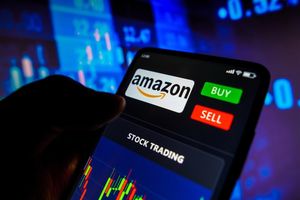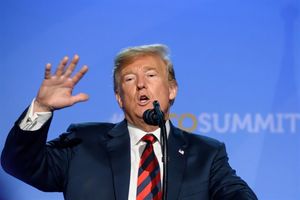Financial News
Today's Market Movers: Inflation, Interest Rates, and Tariffs Drive Wall Street Action

Wall Street is currently navigating a complex and volatile landscape, with investor sentiment heavily influenced by a trifecta of critical economic factors: anticipated inflation data, the Federal Reserve's evolving stance on interest rates, and the persistent shadow of global tariff and trade policies. As August 2025 unfolds, market participants are bracing for key economic reports and policy decisions that could significantly reshape the trajectory of major indices and individual company valuations. The interplay of these forces creates an environment of both opportunity and apprehension, demanding a nuanced understanding from investors and businesses alike.
The immediate implications are palpable across various sectors. While high-quality growth stocks, particularly in technology, have shown remarkable resilience, broader market movements reflect underlying anxieties. The looming inflation figures could dictate the Federal Reserve's next steps, potentially accelerating or delaying much-anticipated interest rate adjustments. Concurrently, the ongoing saga of tariffs continues to exert pressure on supply chains and corporate profitability, forcing companies to re-evaluate their global strategies. This confluence of factors is not merely theoretical; it is actively shaping daily trading volumes, investment decisions, and the overall economic outlook.
A Confluence of Economic Forces: Inflation, Fed Policy, and Trade Wars
The current state of the financial markets is a direct reflection of three powerful economic currents converging: the persistent threat of inflation, the Federal Reserve's delicate balancing act with interest rates, and the pervasive uncertainty stemming from global trade policies. Each of these elements, while distinct, is deeply interconnected, creating a complex web of cause and effect that dictates Wall Street's daily rhythm.
Specifically, the market is on high alert for the release of the July 2025 Consumer Price Index (CPI) and Producer Price Index (PPI) data, scheduled for August 12 and August 14, respectively. Economists are projecting a slight acceleration in headline CPI to 2.8% year-over-year, but the more significant concern lies with core CPI, which is expected to breach the 3% mark for the first time since February, potentially reaching 3.0% year-over-year. This anticipated rise is largely attributed to the pass-through effects of recent tariff implementations on goods ranging from consumer electronics to automobiles and apparel. Should these figures come in higher than expected, it could solidify concerns about "stagflation"—a perilous combination of economic stagnation and high inflation—and potentially force the Federal Reserve into a more hawkish stance, dampening market enthusiasm for rate cuts.
Adding to the complexity are the shifting expectations surrounding Federal Reserve interest rate policy. Following a weaker-than-anticipated July jobs report, market probabilities for a September rate cut have surged, with some analysts now pricing in an 80% to 94% chance. Some Fed officials, like Michelle Bowman, have even publicly advocated for three rate cuts this year, citing the softening labor market as a primary driver. However, Federal Reserve Chair Jerome Powell and other key policymakers maintain a cautious "data-dependent" approach, emphasizing the need to observe more economic indicators, particularly the inflationary impact of tariffs, before committing to further monetary easing. While lower rates typically stimulate economic growth and boost asset prices, the Fed faces a precarious dilemma: cutting too soon risks exacerbating inflation, while delaying could stifle economic activity and increase unemployment.
Finally, the specter of ongoing tariff and trade policies continues to cast a long shadow over global markets. Early August 2025 saw the implementation of new U.S. tariffs on various countries, pushing the average effective U.S. tariff rate to an unprecedented 18.3%—the highest level since the Great Depression. These tariffs, widely viewed by experts like Warren Buffett as a tax ultimately borne by consumers or businesses, are a significant contributor to the anticipated rise in core inflation. The constant fluctuations and inherent uncertainty in trade policy are causing businesses to delay critical decisions regarding hiring and capital expenditures. While some U.S. companies are reportedly increasing domestic investments to mitigate the tariff impacts, others are already reporting profit declines. The nearing expiration of the trade truce with China and the ongoing negotiations for its extension are particularly critical. A failure to extend this truce could reignite a full-blown trade war between the world's two largest economies, triggering a significant "risk-off" sentiment across global markets.
Navigating the Tides: Potential Winners and Losers
The current economic climate, characterized by inflationary pressures, uncertain interest rate trajectories, and persistent trade tensions, is creating a distinct divide between potential winners and losers across various industries and public companies. Strategic positioning and adaptability will be key determinants of success.
Companies with strong pricing power and those operating in sectors less exposed to international supply chains are likely to emerge as relative winners in an inflationary environment. Consumer staples giants like Procter & Gamble (NYSE: PG) and Coca-Cola (NYSE: KO) often demonstrate resilience due to inelastic demand for their products, allowing them to pass on increased costs to consumers. Similarly, domestic-focused infrastructure and manufacturing companies, particularly those benefiting from "reshoring" trends driven by tariffs, could see increased investment and demand. For instance, construction materials suppliers or industrial equipment manufacturers might experience a boost as companies seek to localize production. Furthermore, technology companies with robust recurring revenue models and high gross margins, such as Microsoft (NASDAQ: MSFT) or Adobe (NASDAQ: ADBE), tend to be less sensitive to interest rate fluctuations and can maintain growth even amidst economic uncertainty, making them attractive safe havens for investors.
Conversely, companies heavily reliant on global supply chains, particularly those with significant exposure to countries targeted by tariffs, are facing considerable headwinds. Retailers importing a large volume of goods from China, such as Walmart (NYSE: WMT) or Target (NYSE: TGT), could see their profit margins squeezed as they absorb or pass on increased import costs, potentially impacting consumer demand. Manufacturers with complex international supply chains, like Apple (NASDAQ: AAPL) or Nike (NYSE: NKE), are also vulnerable to disruptions and higher input costs due to tariffs. Furthermore, sectors that are highly sensitive to interest rates, such as real estate investment trusts (REITs) or companies with significant debt burdens, could face challenges if the Federal Reserve maintains a hawkish stance or if borrowing costs remain elevated. Financial institutions, while potentially benefiting from higher net interest margins if rates rise, could also see a slowdown in lending activity if economic uncertainty persists. Companies with high fixed costs and limited ability to adjust prices, especially in competitive markets, will also struggle to maintain profitability amidst rising inflation.
Broader Implications and Industry Shifts
The current economic dynamics extend far beyond individual company balance sheets, signaling significant shifts across entire industries and potentially reshaping the global economic landscape. The interplay of inflation, interest rates, and tariffs is not merely a short-term market fluctuation but rather a catalyst for deeper, more structural changes.
The anticipated rise in core inflation, partly fueled by tariffs, fits into a broader trend of deglobalization and regionalization of supply chains. For decades, companies prioritized efficiency and cost reduction through extensive global networks. However, the recent geopolitical tensions and trade disputes are forcing a re-evaluation. Industries like electronics manufacturing, automotive, and apparel, which have historically relied heavily on international production hubs, are now exploring strategies to diversify their supply chains or even "reshoring" production back to domestic markets. This could lead to increased capital expenditure in developed economies and a revitalization of domestic manufacturing sectors, albeit potentially at higher production costs. The shift could also spur innovation in automation and robotics to offset increased labor costs in higher-wage countries.
The Federal Reserve's cautious approach to interest rate cuts, despite a weakening labor market, highlights a critical policy dilemma. The central bank is attempting to thread a needle between controlling inflation and preventing a recession. This delicate balancing act has significant regulatory and policy implications. Governments may face increased pressure to implement fiscal policies that complement monetary efforts, such as targeted subsidies for domestic industries or investments in infrastructure to boost productivity. Historically, periods of high inflation coupled with slowing growth have often led to increased government intervention in the economy. Comparisons can be drawn to the stagflationary environment of the 1970s, though today's economy benefits from greater technological advancements and more flexible labor markets. However, the risk of a policy misstep remains, potentially leading to either runaway inflation or a deeper economic downturn.
The ongoing tariff saga, with the U.S. average effective tariff rate reaching its highest level since the Great Depression, is a stark reminder of the fragility of international trade relations. While some argue that tariffs protect domestic industries, many economists, including Nobel laureates, contend that they ultimately act as a tax on consumers and businesses, leading to higher prices and reduced economic efficiency. The nearing expiration of the trade truce with China is a critical juncture. A failure to extend this truce could reignite a full-blown trade war, leading to a significant "risk-off" sentiment in global markets, disrupting supply chains further, and potentially triggering retaliatory measures from other trading partners. This could lead to a fragmentation of global trade blocs and a more protectionist international economic order, with long-term implications for global growth and stability.
What Comes Next: Navigating the Uncharted Waters
The coming months promise to be a critical period for financial markets, with several key developments poised to shape both short-term volatility and long-term strategic shifts. Investors and businesses alike must remain agile and prepared for a range of potential scenarios.
In the short term, the immediate focus will be on the upcoming inflation data releases. A higher-than-expected CPI or PPI print could temper expectations for a September interest rate cut, potentially leading to a market pullback as investors recalibrate their outlook on monetary policy. Conversely, softer inflation figures could reinforce the likelihood of a rate cut, providing a boost to equity markets. Beyond the data, the rhetoric from Federal Reserve officials will be closely scrutinized for any hints regarding their collective stance and the pace of future rate adjustments. The outcome of the U.S.-China trade truce negotiations is another immediate concern; a failure to extend the truce could trigger a sharp "risk-off" reaction, particularly impacting multinational corporations and commodity markets.
Looking further ahead, the long-term possibilities are more varied. If inflation proves persistent, the Federal Reserve might be forced to maintain higher interest rates for longer, potentially leading to a more prolonged period of slower economic growth or even a mild recession. This scenario would necessitate strategic pivots for businesses, focusing on cost control, efficiency gains, and strengthening domestic supply chains. Companies might also explore new market opportunities in regions less affected by trade tensions or those with more stable regulatory environments. Conversely, if inflation moderates and the Fed successfully engineers a "soft landing" through measured rate cuts, the market could see a renewed period of growth, albeit potentially at a slower pace than the post-pandemic boom. This would open opportunities for companies to invest in expansion, innovation, and M&A activities.
Emerging market opportunities and challenges will largely depend on how global trade relations evolve. A continued trend towards protectionism could accelerate the reshoring of manufacturing and investment in domestic industries, creating opportunities for local suppliers and service providers. However, it would also pose significant challenges for companies with deeply integrated global operations, forcing them to reconfigure their entire business models. Potential scenarios range from a gradual de-escalation of trade tensions, leading to a more stable global trading environment, to an intensification of trade wars, resulting in fragmented markets and increased economic nationalism. Businesses will need to assess their exposure to these geopolitical risks and develop contingency plans, potentially diversifying their manufacturing bases and sales channels to mitigate future disruptions.
Conclusion: A Market in Flux
The current financial market landscape is undeniably in flux, shaped by the powerful and interconnected forces of inflation, interest rate policy, and global trade dynamics. The anticipated inflation data, particularly the core CPI figures, will serve as a critical barometer for the Federal Reserve's next moves, directly influencing the likelihood and timing of interest rate cuts. Simultaneously, the ongoing saga of tariffs continues to exert pressure on corporate profitability and supply chains, forcing businesses to adapt to a more localized and potentially higher-cost operating environment.
The key takeaway for investors and businesses is the imperative for adaptability and strategic foresight. While high-quality growth stocks and domestic-focused industries may demonstrate resilience, companies with extensive global supply chain exposure or high sensitivity to interest rates face significant headwinds. The broader implications point towards a potential structural shift in global trade, with a move towards regionalization and increased domestic investment. The historical parallels to periods of stagflation serve as a cautionary tale, underscoring the delicate balance the Federal Reserve must maintain.
Moving forward, investors should closely monitor the upcoming inflation reports and the Federal Reserve's subsequent communications for clues on monetary policy. The outcome of the U.S.-China trade truce negotiations will also be a pivotal event, potentially dictating the direction of global markets. Companies, in turn, must continue to assess their supply chain vulnerabilities, explore opportunities for reshoring or diversification, and maintain robust financial health to weather potential economic turbulence. The coming months will undoubtedly test the resilience of both markets and individual enterprises, making informed decision-making and strategic agility paramount for navigating this complex economic environment.
More News
View More




Recent Quotes
View More
Quotes delayed at least 20 minutes.
By accessing this page, you agree to the Privacy Policy and Terms Of Service.



